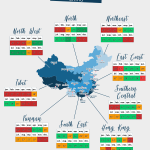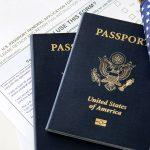Foreign nationals holding ordinary passports must obtain a valid visa in order to visit China, unless they qualify for one of the Chinese Visa Exemption policies. There are two forms of visas available, depending on the purpose and method of visit: individual visas stamped on passports (the most common) and Group Visas issued on paper sheets (a special form).
Once you have successfully obtained your Chinese Visa, it is crucial to carefully review all the details, paying close attention to the visa category, number of entries allowed, validity period, and duration of stay. It is essential to fully understand each section of information to ensure a smooth and successful trip to China.
China Visa on Passport
1. Category (签证种类) – Chinese Visa Types
The Chinese Visa is divided into four categories: diplomatic, courtesy, service, and ordinary visas, depending on the individual’s identity and type of passport. The ordinary visa alone has 16 different types for those visiting the Chinese mainland, in addition to Hong Kong and Macau visas.
Typically, a single English letter is imprinted on the top left corner of the visa page, representing the specific visa category. It is crucial to determine the appropriate visa category before applying and to verify it upon receiving the Chinese Visa. Failure to apply for the correct visa based on the purpose of your visit may result in entry denial.
Types of Chinese Visas:
“L” = China Tourist Visa (for travel purposes)
“M” = China Business Visa (for commercial and trade activities)
“C” = China Crew Visa (for foreign crew members of international transportation and their accompanying family members)
“D” = China Resident Visa (for permanent residency in China)
“F” = China Non-commercial Visit Visa (for exchanges, visits, study tours, etc.)
“G” = China Transit Visa<br>- “Q1/Q2” = China Family Reunion Visa (for visiting family members in China who are Chinese citizens or foreigners with China’s permanent residence)
“S1/S2” = China Private Visa (for visiting family members working or studying in China for private matters)
“X1/X2” = China Study Visa (for studying in China)
“Z” = China Work Visa (for working in China)
These are the major types of visas available for those looking to visit, work, study, or reside in China. Each visa serves a specific purpose and it is important to apply for the correct one based on your intentions in the country.
2. Entries (签证的入境次数)
The number of entries on a Chinese visa refers to how many times you are allowed to enter China during the visa’s period of validity. China offers three entry options to accommodate the varying needs of foreign visitors: regular single-entry, double-entry, and multiple-entry visas. It is worth noting that the Zero-entry Visa is actually an exit visa, meaning it does not allow for re-entry into China.
When completing a visa application form, applicants have the opportunity to select the desired number of entries. However, the Chinese Embassy and Consulates abroad have the final say on the number of entries granted and the duration of stay permitted.
Notes:It is important to remember that you must apply for a new Chinese Visa in two situations: 1.) when you have used up all of your allowed entries, and 2.) when your visa has expired. Attempting to enter China with an expired visa, even if there are entries remaining, will result in rejection.
① Single-entry Chinese Visa
The Single-Entry China Visa permits visitors to enter China only once and is valid for three months from the date of issue. Holders are allowed to stay for a maximum of 30 days within mainland China. If you wish to re-enter China, you will need to apply for a new Chinese Visa.
Pattern on Passport: 01 (壹)
② Double-entry Chinese Visa
Foreigners holding a Double-entry Chinese Visa are permitted to enter mainland China twice within a period of 3 to 6 months from the date of issuance, with each stay lasting up to 30 days.
It is important to be aware that Hong Kong and Macau Special Administrative Regions (SARs) have their own visa and entry permit policies. Therefore, if you plan to visit mainland China first, then travel to Hong Kong or Macau, and later return to mainland China, you will need to obtain a double-entry or multiple-entry Chinese Visa.
Pattern on Passport: 02 (贰)
③ Multiple-entry Chinese Visa
The most popular option for visiting China is the multiple-entry China Visa, as it allows visitors to enter and exit China as many times as they wish within the visa’s validity period. You have the option to apply for a multiple-entry visa for 6 months, 1 year, 2 years, 5 years, and even up to 10 years in countries like the US and UK. The visa fees vary depending on the duration of the visa.
It is important to note that the permitted duration of each stay varies depending on the type of Chinese Visa. For example, Canadian citizens can stay up to 60 days per visit with China L & M Visas, and up to 120 days with a China Q2 Visa. Additionally, there is no limitation on the gap between two individual entries.
Pattern on Passport: M (多)
3. Valid for Entry By (签证的有效期) – Chinese Visa Validity
The “Valid For Entry By” date on a Chinese Visa signifies the expiration date, which is the deadline by which you must enter China. The exact expiration time is 24:00 of China’s official time (Beijing GMT+8:00). The total period of validity begins on the “Valid For Entry By” date and extends for the number of days specified on the visa. The duration of validity varies depending on the type of visa and the number of entries allowed, typically ranging from 3 months to 1 year or more. It is important to note that visitors will not be permitted entry into China if the specified time has already passed as indicated on the visa.
Format on Passport: YY-MM-DD
4. Duration of Each Stay (停留期限) – Days After Entry
On the right section next to “Valid For Entry By,” the term “Duration of Each Stay” refers to the maximum number of days visitors are permitted to stay in China per entry. This duration is calculated from 00:00 on the day following entry into China until 24:00 (Beijing GMT +8:00) on the last permitted day. It is important to note that this duration is counted each time you enter China, rather than being cumulative.
The specific “Duration of Each Stay” varies depending on the type of visa issued. This duration can range from a few days to a maximum of 180 days, with a standard stay for a Tourist (L) Visa being 30 days. If you wish to extend your stay beyond the duration specified on your visa, you must apply for a China Visa Extension from the public security authorities at least one week before the expiration date. It is essential to adhere to these regulations, as overstaying is a violation of Chinese law.
For certain long-term Chinese Visas, such as the China Work (Z) Visa, China Study (X1/X2) Visa, China Foreign Journalist (J1) Visa, and China Resident (D) Visa, the term “000” days may be indicated. This does not mean that the bearer is prohibited from staying in China or that there is no limit on the duration of their stay. Instead, individuals holding these visas are required to apply for a residence permit at the local Public Security Bureau within 30 days of their arrival. The specific duration of their stay will be outlined on the residence permit.
5. Others Information on China Visa Page
- China Visa Number: This unique code consists of 1 capital Latin letter and 7 Arabic numerals, totaling 8 digits. It serves as the sole identifier for your Chinese Visa.
- Date of Issue: This is the date on which your Chinese Visa is issued, marking the beginning of its validity period.
- Place of Issue: This section displays the name of the city or region in Chinese characters, indicating the location of the Chinese Embassy or Consulate where the visa was issued.
- Full Name, Date of Birth, and Passport Number are essential personal details that must be accurately stamped on the visa.
China Tourist Group Visa
The China Tourist Group Visa is a unique type of Chinese visa that is issued to a tour group consisting of at least 5 members and organized by a local travel agency. Unlike the regular individual visa that is stamped on a passport, the Group Visa is printed on a sheet of paper, detailing personal information about all tourists, including their name, gender, nationality, date of birth, passport number, passport validity, and occupation.
As of June 1st, 2019, a new China Group Visa form has been introduced, similar to the regular Chinese Visa. All group tourists are required to enter and exit China through the same port at the same time.
This visa is a convenient option for tour groups traveling together, ensuring that all members are processed efficiently and can enjoy their trip to China without any issues.




















